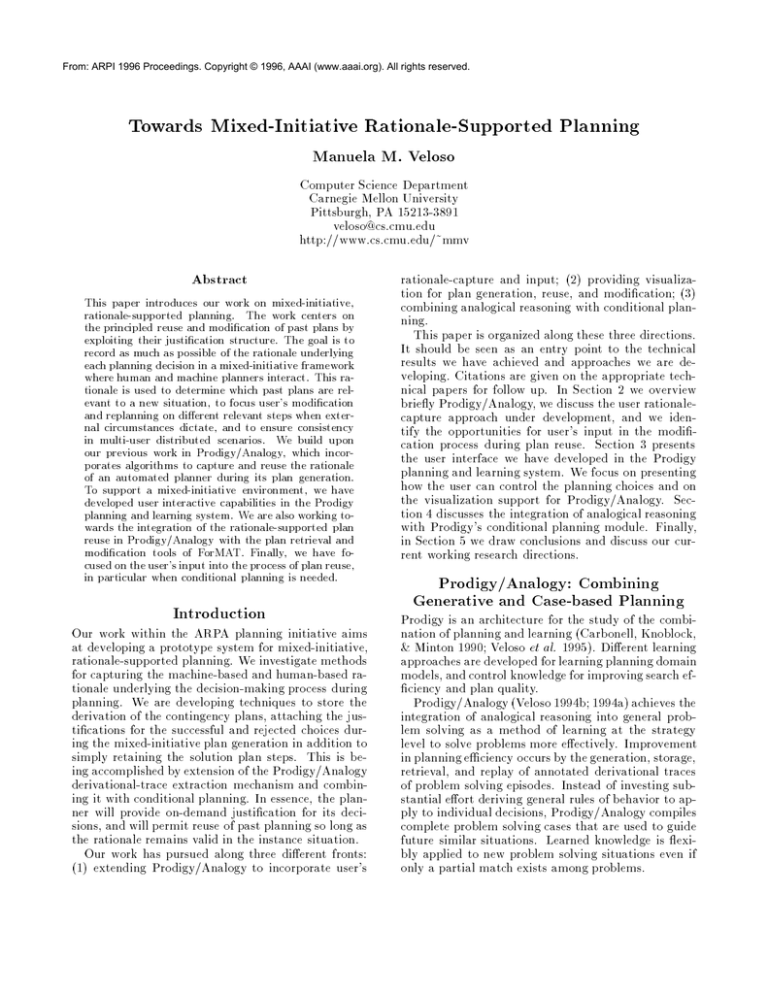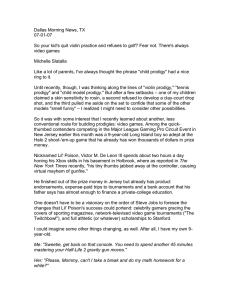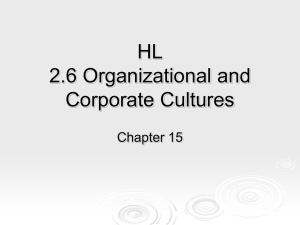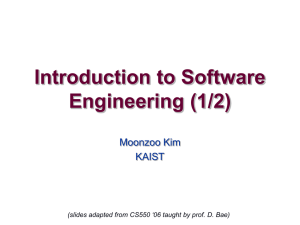
From: ARPI 1996 Proceedings. Copyright © 1996, AAAI (www.aaai.org). All rights reserved.
Towards Mixed-Initiative Rationale-Supported Planning
Manuela M. Veloso
Computer Science Department
Carnegie Mellon University
Pittsburgh, PA 15213-3891
veloso@cs.cmu.edu
http://www.cs.cmu.edu/~mmv
Abstract
This paper introduces our work on mixed-initiative,
rationale-supported planning. The work centers on
the principled reuse and modication of past plans by
exploiting their justication structure. The goal is to
record as much as possible of the rationale underlying
each planning decision in a mixed-initiative framework
where human and machine planners interact. This rationale is used to determine which past plans are relevant to a new situation, to focus user's modication
and replanning on dierent relevant steps when external circumstances dictate, and to ensure consistency
in multi-user distributed scenarios. We build upon
our previous work in Prodigy/Analogy, which incorporates algorithms to capture and reuse the rationale
of an automated planner during its plan generation.
To support a mixed-initiative environment, we have
developed user interactive capabilities in the Prodigy
planning and learning system. We are also working towards the integration of the rationale-supported plan
reuse in Prodigy/Analogy with the plan retrieval and
modication tools of ForMAT. Finally, we have focused on the user's input into the process of plan reuse,
in particular when conditional planning is needed.
Introduction
Our work within the ARPA planning initiative aims
at developing a prototype system for mixed-initiative,
rationale-supported planning. We investigate methods
for capturing the machine-based and human-based rationale underlying the decision-making process during
planning. We are developing techniques to store the
derivation of the contingency plans, attaching the justications for the successful and rejected choices during the mixed-initiative plan generation in addition to
simply retaining the solution plan steps. This is being accomplished by extension of the Prodigy/Analogy
derivational-trace extraction mechanism and combining it with conditional planning. In essence, the planner will provide on-demand justication for its decisions, and will permit reuse of past planning so long as
the rationale remains valid in the instance situation.
Our work has pursued along three dierent fronts:
(1) extending Prodigy/Analogy to incorporate user's
rationale-capture and input; (2) providing visualization for plan generation, reuse, and modication; (3)
combining analogical reasoning with conditional planning.
This paper is organized along these three directions.
It should be seen as an entry point to the technical
results we have achieved and approaches we are developing. Citations are given on the appropriate technical papers for follow up. In Section 2 we overview
briey Prodigy/Analogy, we discuss the user rationalecapture approach under development, and we identify the opportunities for user's input in the modication process during plan reuse. Section 3 presents
the user interface we have developed in the Prodigy
planning and learning system. We focus on presenting
how the user can control the planning choices and on
the visualization support for Prodigy/Analogy. Section 4 discusses the integration of analogical reasoning
with Prodigy's conditional planning module. Finally,
in Section 5 we draw conclusions and discuss our current working research directions.
Prodigy/Analogy: Combining
Generative and Case-based Planning
Prodigy is an architecture for the study of the combination of planning and learning (Carbonell, Knoblock,
& Minton 1990; Veloso et al. 1995). Dierent learning
approaches are developed for learning planning domain
models, and control knowledge for improving search efciency and plan quality.
Prodigy/Analogy (Veloso 1994b; 1994a) achieves the
integration of analogical reasoning into general problem solving as a method of learning at the strategy
level to solve problems more eectively. Improvement
in planning eciency occurs by the generation, storage,
retrieval, and replay of annotated derivational traces
of problem solving episodes. Instead of investing substantial eort deriving general rules of behavior to apply to individual decisions, Prodigy/Analogy compiles
complete problem solving cases that are used to guide
future similar situations. Learned knowledge is exibly applied to new problem solving situations even if
only a partial match exists among problems.
Goal Node
:step
:sibling-goals
:sibling-appl-ops
:why-subgoal
:why-this-goal
:precond-of
From: ARPI 1996 Proceedings. Copyright © 1996, AAAI (www.aaai.org). All rights reserved.
Figure 1 illustrates the complete planning cycle
of Prodigy/Analogy. Generative planning using an
operator-based planner, Prodigy4.0 (Carbonell et al.
1992), is used if additional planning is needed when
replaying the past planning cases.
Justification-Based REPLAY
RETRIEVAL
Similar scenario
Similar goals
ADAPT, MERGE
planning cases
Extra work:
Operator-Based
Planner
L I B R A R Y
O F
STORAGE
Relevant features
of scenario
GENERATION
Rationale capture
Successes and failures
Multiple indexing by
goal interactions
P L A N N I N G
C A S E S
Figure 1: Prodigy/Analogy: Retrieval, replay, generation, and storage of planning cases. An operator-based
planner is used as a generative planner when additional
planning is needed.
Generation of planning episodes
Reasoning by analogy in Prodigy/Analogy consists
of the exible reuse of derivational traces of previously solved problems to guide the search for solutions
to similar new problems, avoiding a completely new
search eort. Transformationalanalogy and most CBR
systems reuse past solutions by modifying (tweaking)
the retrieved nal solution as a function of the dierences found between the source and the target problems. Derivational analogy instead is a reconstructive
method by which lines of reasoning are transferred and
adapted to a new problem (Carbonell 1986) as opposed
to only the nal solutions.
Automatic generation of the derivational episodes
that become the planning cases occurs by extending the base-level planner with the ability to examine its internal decision cycle, recording the justications for each decision during its search process. Prodigy/Analogy has been re-implemented in
Prodigy4.0, a state-space nonlinear planner (Carbonell
et al. 1992; Fink & Veloso 1994).
Prodigy4.0's planning reasoning cycle involves several decision points, namely: the goal to select from
the set of pending goals; the operator to choose to
achieve a particular goal; the bindings to choose in order to instantiate the chosen operator; apply an operator whose preconditions are satised or continue subgoaling on a still unachieved goal. Prodigy/Analogy
extends Prodigy4.0 with the capability of recording
the context in which the decisions are made. Figure 2
shows the skeleton of the decision nodes. We created
a language for the slot values to capture the reasons
that support the choices (Veloso & Carbonell 1993a).
There are mainly three dierent kinds of justications: links among choices capturing the subgoaling
structure (slots precond-of and relevant-to), records
Chosen Op Node
:step
:sibling-ops
:why-this-op
:relevant-to
Applied Op Node
:step
:sibling-goals
:sibling-appl-ops
:why-apply
:why-this-op
:chosen-at
Figure 2: Justication record structure. Nodes are
instantiated at decision points during problem solving.
Each learned episode is a sequence of such justied
nodes.
of explored failed alternatives (the sibling- slots), and
pointers to any applied guidance (the why- slots). A
stored problem solving episode consists of the successful solution trace augmented with these annotations,
i.e., the derivational trace.
Mixed-initiative rationale capture The genera-
tion of planning cases by Prodigy/Analogy captures
the rationale of the machine-based planning. We
have been addressing two dierent aspects of a mixedinitiative planning framework.
In a simpler approach, we assume that the user is
familiar with the Prodigy planning cycle. We provide
user interactive capabilities to allow a user to choose
particular alternatives in the cases and plan merging
strategies (see section below). Justications provided
by the user in general are selected from a set of available ones. If the user enters an unknown reason to
the system, its functionality needs to be specied for
validation at reuse time.
We are engaged in a technology integration experiment (TIE) with MITRE to address a more realistic
user-based planning scenario. MITRE's ForMAT system provides a plan acquisition tool that allows users
to generate and save force deployment plans (Mulvehill 1996). Stored plans are long lists of actions that
are recorded without the underlying rationale structure. ForMAT incorporates mechanisms for the user
to provide some organizational structure. It can also
infer weighted functional information about dierent
force modules of the plans.
The TIE will combine ForMAT for its user-based
planner and for its case library with Prodigy/Analogy
for its rationale-driven reuse capabilities. Rationalesupported reuse relies on the reasons for plan step selection, the actual goals to be achieved, and the alternative steps that were or should be considered. We
are developing ways to extract dependency and ordering information from ForMAT plans. We recognized
the need to augment the stored plans with the goals
of the constituent force modules. Currently, we have
a small case library of force deployment plans which
includes a high-level denition of the user's rationale
associated with the dierent force modules. This information is converted into Prodigy/Analogy goal-based
planning case representation.
Replay of multiple guiding cases
From: ARPI 1996 Proceedings. Copyright © 1996, AAAI (www.aaai.org). All rights reserved.
When a new problem is proposed, prodigy/analogy
retrieves from the case library one or more problem
solving episodes that may partially cover the new problem solving situation. The system uses a similarity
metric that weighs goal-relevant features (Veloso &
Carbonell 1993b). In a nutshell, it selects a set of past
cases that solved subsets of the new goal statement.
The initial state is partially matched in the features
that were relevant to solving these goals in the past.
Each retrieved case provides guidance to a set of interacting goals from the new goal statement. At replay
time, a guiding case is always considered as a source of
guidance, until all the goals it covers are achieved.
The general replay mechanism involves a complete
interpretation of the justication structures annotated
in the past cases in the context of the new problem
to be solved. Equivalent choices are made when the
transformed justications hold. When that is not the
situation, prodigy/analogy plans for the new goals
using its domain operators adding new steps to the
solution or skipping unnecessary steps from the past
cases.
The replay functionality transforms the planner,
from a module that costly generates possible operators
to achieve the goals and searches through the space of
alternatives generated, into a module that tests the validity of the choices proposed by past experience and
follows equivalent search directions. The replay procedure provides the following benets to the problem
solving procedure:
Proposal and validation of choices versus generation
and search of alternatives.
Reduction of the branching factor { past failed
alternatives are pruned by validating the failures
recorded in the past cases; if backtracking is needed
prodigy/analogy backtracks also in the guiding
cases { through the links established during replay
{ and uses information on failure to make more informed backtracking decisions.
Subgoaling links identify the subparts of the case to
replay { the steps that are not part of the active
goals are skipped.
prodigy/analogy constructs a new solution from
a set of guiding cases as opposed to a single past case.
Complex problems may be solved by resolving minor
interactions among simpler past cases. However, following several cases poses an additional decision making step of choosing which case to pursue. We explored
several strategies to merge the guidance from the set of
similar cases. We have experimented with exploratory
and informed merging strategies. In the exploratory
approach, choices are made arbitrarily when there is
no other guidance available. This strategy allows an
innovative exploration of the space of possible solutions leading to opportunities to learn from new goal
interactions or operator choices.
We have applied the rationale-supported planning
framework of Prodigy/Analogy in several domains including a realistic route planning domain using the real
map of the Pittsburgh city (Haigh, Veloso, & Shewchuk
1996; Haigh & Veloso 1995).
Mixed-initiative plan reuse and modication
There are several opportunities for user intervention
in plan reuse. Before the actual plan reuse episode,
the user may be involved in the retrieval process. In
our TIE, ForMAT provides useful tools to allow users
to query the library of planning cases until a suciently similar past scenario is found. Retrieval in
Prodigy/Analogy is driven by goal and initial scenario
similarities. We combine the functional querying in
ForMAT with the goal information for ecient retrieval.
The replay procedure in Prodigy/Analogy includes
role substitutions at the plan step level. It processes
not only the substitutions returned by the retrieval
procedure, but also the ones identied during the justication interpretation during the actual plan reuse.
This avoids the user's eort to identify the implications of the partial match between the past and new
planning scenarios.
During reuse, Prodigy/Analogy needs to modify and
adapt the new plans. In the fully automated system,
as described above, when extra planning is needed,
the generative operator-based planner is invoked to
plan for the additional goals encountered. In a realistic mixed-initiative framework, it is quite possible
that the generative planner does not have the domain
knowledge for extra planning needed. In this case,
Prodigy/Analogy invokes ForMAT which accesses its
case library or supports the user for plan building
for the new goals. Within this system integration,
Prodigy/Analogy will provide informed removal and
insertion of new plan modules by following the rationale that links the dierent parts of the plans.
User Interface
Along the mixed-initiative paradigm, we have designed
and developed a user interface for the Prodigy planning
and learning system (Blythe, Veloso, & de Souza 1996).
The interface supports the process of both building
and running a planning domain. It was designed to be
highly modular, requiring no changes to the underlying planner's code, and extensible, so that interfaces to
modules added to the planner may could easily be integrated into the interface. When desired, a human user
can step through and interrupt the planning process,
as well as provide choices for the planning decisions.
The user interface supports planning by reuse of past
planning episodes and probabilistic planning.
Since Prodigy is an on-going research project, it was
important to develop an interface that could be integrated easily with any variant of the system and with
its dierent learning modules. This requirement led us
From: ARPI 1996 Proceedings. Copyright © 1996, AAAI (www.aaai.org). All rights reserved.
to seek an architecture that is modular in two ways.
First, the code for the planner should not need to be
modied for the user interface to run. Second, the
user interface itself should make very few assumptions
about the planner's implementation. At the same time
the interface should have a tight integration with the
planner so that the planning process can be traced
graphically and the interface can be used to interrupt
and direct the planner while it is in operation. The
architecture used for the prodigy user interface accomplishes these goals and the implementation details
can be found in (Blythe, Veloso, & de Souza 1996). In
this paper, we focus on describing briey how the user
can control the planning choices and on the visualization support for Prodigy/Analogy.
Control of planning choices
is a completely open-controllable architecture. This means that all the decision points are
open to be controlled explicitly usually through control rules which can automatically dictate particular
choices based on the planning scenario. Figure 3 illustrates a particular use of control rules that interrupt
the planner to ask the user for guidance.
prodigy
new or non-existing goals in the new scenario. We have
developed a series of methods to merge dierent planning episodes which reason about dierent degrees of
context information to guide their merging process. In
particular, a user-driven merging procedure has been
developed. We have created a simple language that
allows to interact with the user. This is currently under further renement to facilitate the user's task of
combining and updating past plan rationale in new
contexts.
Prodigy/Analogy's running mode can be selected
from the interface. The user can solve problems and
request that the planning episodes be stored. A new
problem can then be solved by replaying and and merging possibly multiple past planning cases. Figure 4
shows a snapshot of the interface where one case is
instantiated to guide two dierent goals.
Figure 4: A snapshot of the setup used by the analogical reasoning module. Guiding cases are displayed
as shown in the two windows at the right. The steps
reused are marked while the steps not needed in the
new situation are skipped.
Figure 3: The user can control choices. In the right
window, the user is shown the operator choices available to achieve the goal Prodigy is planning for.
The user is prompted with the choices available and
can either select one of the alternatives, decide that
doesn't know which one to select, or tell prodigy
not to ask for any more guidance and resume its autonomous behavior.
The interface for Prodigy/Analogy
To reuse past planning experience to solve new complex planning situations, it may be necessary to reuse
multiple past planning episodes. Planning becomes
therefore a merging process of multiple plans, probably simpler and complementary. An automated merging procedure compares interactions in the past with
the new scenario. In the new situation, the planner is
capable of: reordering actions, adding new needed actions and deleting old actions as a function of possibly
The user can visualize the merging procedure, as it
interleaves the multiple cases, marks the steps that are
used after successful validation, and skips the ones that
are no longer necessary or are invalid.
Using Analogy in Conditional Planning
Given the uncertainty of planning in complex situations, we also developed a method to combine
analogical replay with conditional probabilistic planning (Blythe 1994; Blythe & Veloso 1996).
Recently, several planners have been designed that
can create conditionally branching plans to solve problems which involve uncertainty. These planners represent an important step in broadening the applicability of AI planning techniques, but they typically
must search a larger space than non-branching planners, since they must produce valid plans for each
branch considered. In the worst case this can produce
an exponential increase in the complexity of planning.
If conditional planners are to become usable in realworld domains, this complexity must be controlled by
sharing planning eort among branches. We therefore
From: ARPI 1996 Proceedings. Copyright © 1996, AAAI (www.aaai.org). All rights reserved.
argue that analogical plan reuse should play a fundamental role in this process. We have implemented a
conditional probabilistic planner that uses analogical
replay to derive the maximum benet from previously
solved branches of the plan. This approach provides
valuable guidance for when and how to merge dierent
branches of the plan and exploits the high similarity
between the dierent branches, which have the same
goal and typically a very similar state. Our experiments have been showing that analogical replay significantly reduces the complexity of conditional planning.
Through its replay functionality, Prodigy/Analogy
showed to be suitable to be combined with C-Prodigy,
the conditional planner developed by Blythe. Table 1
introduces how conditional planning controlled by the
probabilistic planner Weaver (Blythe 1994), is integrated with Prodigy/Analogy. It is interesting to notice the smoothness of this integration which is made
possible by the common underlying framework of the
Prodigy planning and learning system.
Procedure C-Prodigy-Analogy
1. Weaver and Analogy select which previously visited
branch should be used to guide the new planning of conditional planning.
2. Based on the selected branching point, Analogy sets up
accordingly the starting guiding point of the past planning episode.
3. C-Prodigy plans for the new branch guided by Analogy.
4. The integrated C-Prodigy/Analogy new planning
episode proceeds in the same way as the usual
Prodigy/Analogy: in this new context, previous decisions are followed if valid, unnecessary steps are not used,
and new steps are added when needed. This process is
equivalent in either of the two situations described above
identied by Weaver. Whether C-Prodigy is trying to
protect a potentially unsuccessful step, or replanning for
a new branch, Analogy guides the new planning process
based on the high similarity between the global current
and past situations. This is particularly well suited for
the analogical replay guidance and leads in general to
minor interactions and a major sharing of the past planning eort.
Table 1: Top-level view of the integration of analogy
in conditional probabilistic planning.
In general, Prodigy/Analogy allows for the replay of
any number of past cases that are found to be jointly
similar to a new planning situation. The planning
cases are retrieved from a library of cases, similarities are evaluated, and appropriate substitutions are
performed.
In this integration of conditional planning and analogy, the analogical replay within the context of dierent branches of the same problem can be better framed
as an instance of internal analogy (Hickman, Shell, &
Carbonell 1990). In fact, the accumulation of a library
of cases is not required, and there is no need for an
elaborated analysis of similarity between a new problem and a potentially large number of dierent cases.
The branches of the problem need only to be cached
in working memory and most of the objects do not
need to be mapped into new objects, as the context
remains the same. In our implementation, we set up
Prodigy/Analogy with the ability to follow this same
internal-analogy philosophy. However the full analogical reasoning paradigm leaves us with the freedom to
reuse branches across dierent problems in the same
domain. We could also nd the need to merge dierent
branches in a new situation. Our current implementation leaves these possibilities well open, as they are part
of the functionality of the general Prodigy/Analogy.
Table 2 presents the analogical reasoning procedure
combined with conditional planning. We follow a single
case corresponding to the planning for the last branch
visited according to the replanning order selected by
Weaver.
procedure
c-prodigy-analogical-replay
1. Let C be the guiding case;
and Ci is the guiding step in the case.
2. The initial case step C0 is set at the branching point.
3. Let i = 0.
4. Terminate if the goal state is reached.
5. Check which type of decision is Ci :
6. If Ci adds a step Og to the head plan,
7. If Og can be added to the current head plan
and no tail planning is needed before,
8.
then Replay Ci ; Link new step to Ci ; goto 14.
9.
else B-planning plans for the new goals; goto 5.
10.If Ci adds a step Og to the tail plan,
11. If the step Og is valid,
12. then Replay Ci ; Link new step to Ci ; goto 15.
13. else Hold the case (if other planning needed), or
Mark unusable all steps dependent of Ci ; goto 14.
14.Advance the case to the next usable step Cj ;
15. i j ; goto 5.
Table 2: Sketch of the analogical replay procedure
combined with conditional planning.
The adaptation in the replay procedure involves a
validation of the steps proposed by the case. There
may be a need to diverge from the proposed case step,
because new goals exist in the current branch (step 9).
There may be also the case that some steps in the old
branch can be skipped, as they may be already true in
the new branching situation (step 13). Steps 8 and 12
account for the sharing between dierent branches.
These steps also account for the most part of the new
planning, as the state is only slightly dierent and most
of the goals are the same across branches. This selective use of replay controls the combinatorics of conditional planning.
Conclusion
From: ARPI 1996 Proceedings. Copyright © 1996, AAAI (www.aaai.org). All rights reserved.
We presented methods to extend Prodigy/Analogy to
capture the user's rationale in a mixed-initiative framework. We have briey described our technology integration experiment with MITRE's ForMAT case-based
planning system. We have identied several opportunities where the retrieval and modication mechanisms of ForMAT can be merged with the rationalesupported reuse of Prodigy/Analogy. Our work has
been based on ForMAT's force deployment plans and
ACP analogs created at MITRE.
We presented a few of the user interactive capabilities that we developed in a user interface for
the Prodigy system, including for Prodigy/Analogy.
To address issues of ecient conditional planning
to handle uncertainty, we have also integrated
Prodigy/Analogy with C-Prodigy, Prodigy's conditional planner developed by Blythe.
The paper summarized our directions of research
within the ARPI planning initiative. The paper reports on our on-going work towards ecient mixedinitiative rationale-supported planning.
Acknowledgements
This research is sponsored in part by the Advanced Research Projects Agency (ARPA) and the Rome Laboratories (RL) as part of the ARPA/RL Knowledge Based
Planning and Scheduling Initiative the under grant number
F30602-95-1-0018. The views and conclusions contained in
this document are those of the authors and should not be
interpreted as necessarily representing the ocial policies
or endorsements, either expressed or implied, of the Rome
Laboratories or the U.S. Government.
Thanks to Jim Blythe, Luiz de Sousa, and Karen Haigh
for their help in the development of the user interface. The
work on using analogy in conditional planning has been
done jointly with Jim Blythe. Thanks also to Jaime Carbonell for his suggestions and discussions on this work. Finally, special thanks to Alice Mulvehill and Steven Christey
from MITRE, and Michael Cox for our TIE with ForMAT.
References
Blythe, J., and Veloso, M. 1996. Using analogy in
conditional planners. Technical Report forthcoming,
Computer Science Department, Carnegie Mellon University.
Blythe, J.; Veloso, M.; and de Souza, L. E. 1996. The
Prodigy user interface. Technical Report forthcoming, Computer Science Department, Carnegie Mellon
University.
Blythe, J. 1994. Planning with external events. In
de Mantaras, R. L., and Poole, D., eds., Proceedings of
the Tenth Conference on Uncertainty in Articial Intelligence, 94{101. Seattle, WA: Morgan Kaufmann.
Carbonell, J. G.; Blythe, J.; Etzioni, O.; Gil, Y.;
Joseph, R.; Kahn, D.; Knoblock, C.; Minton, S.;
Perez, A.; Reilly, S.; Veloso, M.; and Wang, X. 1992.
PRODIGY4.0: The manual and tutorial. Technical
Report CMU-CS-92-150, Department of Computer
Science, Carnegie Mellon University.
Carbonell, J. G.; Knoblock, C. A.; and Minton, S.
1990. Prodigy: An integrated architecture for planning and learning. In VanLehn, K., ed., Architectures
for Intelligence. Hillsdale, NJ: Erlbaum. Also Technical Report CMU-CS-89-189.
Carbonell, J. G. 1986. Derivational analogy: A theory of reconstructive problem solving and expertise
acquisition. In Michalski, R. S.; Carbonell, J. G.; and
Mitchell, T. M., eds., Machine Learning, An Articial
Intelligence Approach, Volume II, 371{392. Morgan
Kaufman.
Fink, E., and Veloso, M. 1994. PRODIGY planning
algorithm. Technical Report CMU-CS-94-123, School
of Computer Science, Carnegie Mellon University.
Haigh, K. Z., and Veloso, M. 1995. Route planning by analogy. In Case-Based Reasoning Research
and Development, Proceedings of ICCBR-95, 169{
180. Springer-Verlag.
Haigh, K. Z.; Veloso, M. M.; and Shewchuk, J. 1996.
Exploring geometry in analogical route planning. Submitted to Journal of Experimental and Theoretical Articial Intelligence.
Hickman, A. K.; Shell, P.; and Carbonell, J. G. 1990.
Internal analogy: Reducing search during problem
solving. In Copetas, C., ed., The Computer Science
Research Review 1990. The School of Computer Science, Carnegie Mellon University.
Mulvehill, A. M. 1996. Building, remembering, and
revising force deployment plans. In In this same volume.
Veloso, M. M., and Carbonell, J. G. 1993a. Derivational analogy in prodigy: Automating case acquisition, storage, and utilization. Machine Learning
10:249{278.
Veloso, M. M., and Carbonell, J. G. 1993b. Towards scaling up machine learning: A case study
with derivational analogy in prodigy. In Minton, S.,
ed., Machine Learning Methods for Planning. Morgan
Kaufmann. 233{272.
Veloso, M.; Carbonell, J.; Perez, M. A.; Borrajo, D.;
Fink, E.; and Blythe, J. 1995. Integrating planning
and learning: The PRODIGY architecture. Journal
of Experimental and Theoretical Articial Intelligence
7(1):81{120.
Veloso, M. M. 1994a. Flexible strategy learning: Analogical replay of problem solving episodes. In Pro-
ceedings of Twelfth National Conference on Articial
Intelligence, 595{600. Seattle, WA: AAAI Press.
Veloso, M. M. 1994b. Planning and Learning by Analogical Reasoning. Springer Verlag. (Monograph of
Ph.D. thesis, Carnegie Mellon University, 1992).









